At GDC 2013 I was onstage three times — twice to speak about Versu, but once also at the Indie Soapbox, which is a session in which ten indie game developers get five minutes each to talk about whatever they want. The soapbox topics were extremely varied and covered everything from the pleasures of writing indie games while traveling the world to publicity challenges to how to make interactive music that changes as the gameplay changes.
I talked about interactive text. Actually, I kind of ranted about interactive text.
The gist of my rant was: text is not just cheap. It’s not just the medium you use when you have no resources and no high-end software. It’s a very powerful medium for communicating nuance, viewpoint, interiority, motivation, the experience of the outsider. It’s an artistic medium with its own beauties. And because language is all around us, embodying cultural norms and politics, word-mechanics can address big issues.
Sometimes in the game industry you encounter people who don’t respect text, or don’t respect the craft of writing, as though creating good text were less expressive than creating good art, or less challenging than creating good code. That’s their error.
Sometimes people assume text games must be ugly and have low production values. That isn’t true either. It is possible for text games to be visual feasts.
Here are some of the pieces I talked about or didn’t get time to talk about, and one or two more that I might have talked about if they’d been out at the time.
I talked about:
Our project at Linden Lab, Versu — just briefly, apropos of the point that doing text-based work is something I find highly compelling. (More of my posts about Versu.)
howling dogs by Porpentine. Twine interactive fiction appearing in the IF Comp. I talked about how individual sentences stayed with me, about the flexibility of text, about its capacity to hint at ideas that you can dwell on for weeks. Twine has become a significant creative tool for a community of queer authors writing about their experiences and topics rarely covered in games.
The Baron by Victor Gijsbers. I talked about how this piece asks you not just what you want to do but why you’ve chosen to do that, and how motivation and purpose are expressible in text choices in a way that’s very hard to arrange elsewhere.
maybe make some change, Aaron Reed. I talked about how the narrative is retold in different words to reveal different perspectives, and how the verbs you have available shift to represent your different options, your training and attitude towards your situation.
I wish I could also have covered:
Zero Summer, Gordon Levine et al for StoryNexus. Zero Summer is joyously verbose, playing with the idioms of the western. It’s also an excellent example of the StoryNexus engine at work. (My review, followup.) And, of course, it’s worth a look at the original game that gave rise to StoryNexus, Fallen London.
inklewriter fiction — in this case, an adapted Sherlock Holmes story. inklewriter combines easy creation tools with a classy presentation. (My tool discussion.) inklewriter is seductively easy to get into and use, and permits export of the resulting work to Kindle formats as well.
The Girl and the Wolf, Nick Montfort: a variable fairy tale where you can choose how much violence and how much sex you want in your retelling of Little Red Riding Hood, from a 3-by-3 grid. There is a Spanish translation as well.
Silent Conversation by Gregory Weir, a platformer of sorts in which you traverse concrete poetry. In one level the words “the moon” hover faded and pale grey above the rest of the line of text. The challenge is to make contact with each bit of text on the way, but some words are dangerous and sinister, sending off ghostly red forms that endanger the player figure.
Guilded Youth by Jim Munroe. Vorple-driven IF with a front end that hearkens back to dial up BBSes. (My review.)
ChoiceScript games from Choice of Games, stats-heavy choice-based fiction, often with a heavy emphasis on creating your own character and developing your preferred persona, sexuality, and preferences.
iOS gamebooks from Gamebook Adventures, which reproduce the sensation of book-and-dice experiences from past decades.
The Colder Light, Jon Ingold’s gorgeous button-navigated puzzle IF that makes the straight-up parser more navigable while keeping around a lot of the world model. (My review.)
18 Cadence, Aaron Reed’s brand-new iOS and web-based work of “fridge narrative”, allowing the reader to explore the history of a particular house, the uses of its space, the objects and people found there; and then to take snippets of prose and reassemble them, presenting particular narratives or themes. (My review.)
Poems by Heart, by inkle for Penguin Classics. A game of learning poetry.
Bee (mine), in Varytale, a system designed to emphasize the literary aspects of interactive narrative. It uses principles of quality-based narrative — that is, tracking a number of behind the scenes variables in order to decide what scenes and options should be presented to the player — similar to Fallen London and StoryNexus games.
Living Will, Mark Marino in Undum. About a will that revises itself through choice, a document designed to communicate with a dead (or dying) man. (My review.)
First Draft of the Revolution, me, Liza Daly, and inkle. Interactive epistolary in which the mechanic is rewriting letters, deciding what to reveal and what to hide.
My Secret Hideout, Andrew Plotkin for iOS. Manipulate descriptive text by manipulating the randomizing seeds that create that text. (My review.)
Desiring Flights, Barry Moon in Unity. Desiring Flights treats words as bulky 3D objects, precariously placed in space. (My coverage from the IF Demo Fair, including coverage of several other pieces of interactive poetry.)
Strange Rain, Opertoon/Erik Loyer for iOS, an experience in text and color and music and simulated rainfall. (My review.)
Ex Nihilo, Juhana Leinonen, Vorple; an experience that stores input from other players, creating a sort-of-multiplayer experience.
This is, of course, a very short and very incomplete list. There’s lots more classic parser IF I could have included, but part of my aim with this collection of screenshots was to demonstrate the very wide range of styles and looks and show that a number of text-based games are attractive, polished, aesthetically appealing.
And then there are all the letter-based games — Scrabble and Boggle, Words with Friends, IF games with a wordplay concept, Apples to Apples, Scattergories, Cards Against Humanity. Family games, casual games, mobile and desktop games. Not all of these are remotely the same kind of game, of course, but that’s kind of my point.
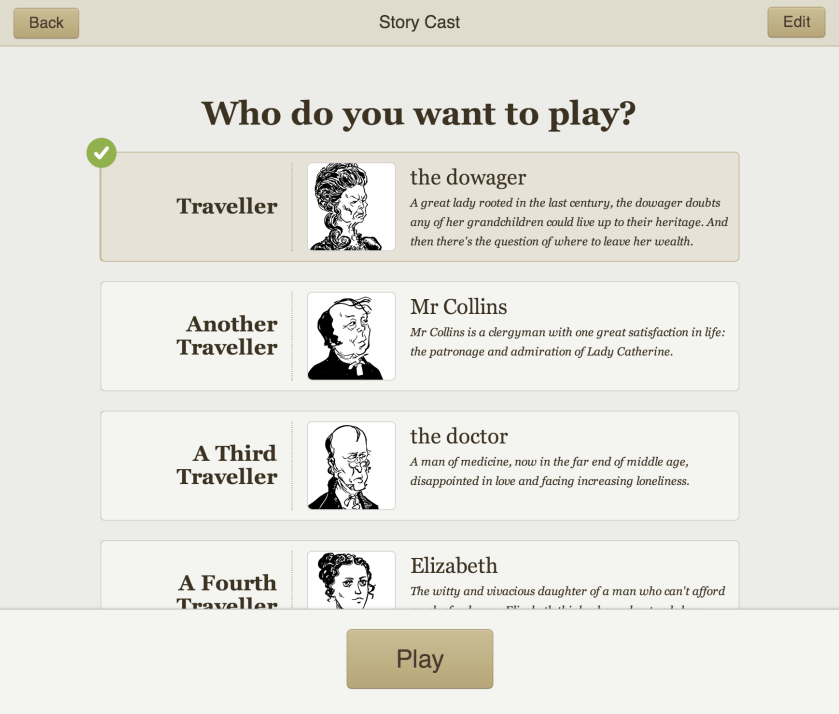

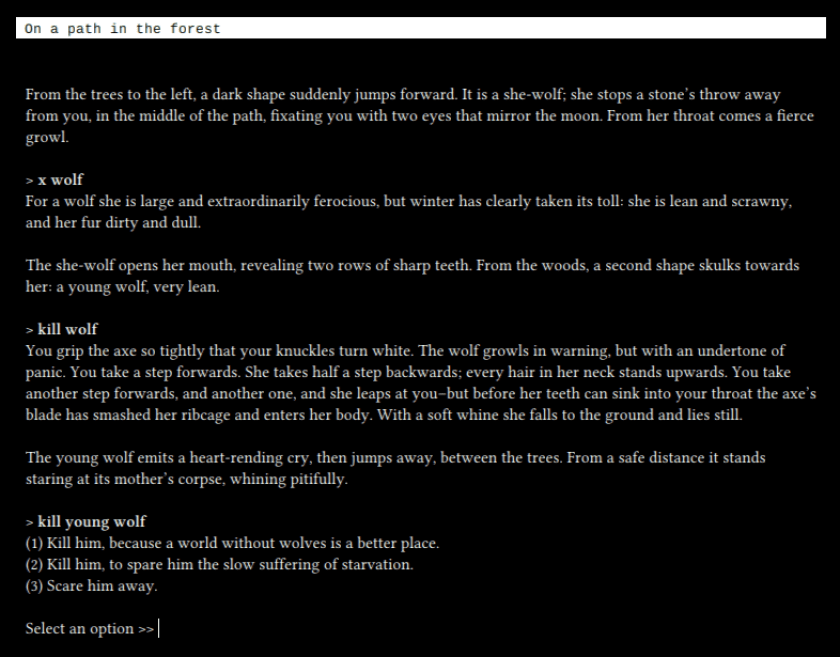
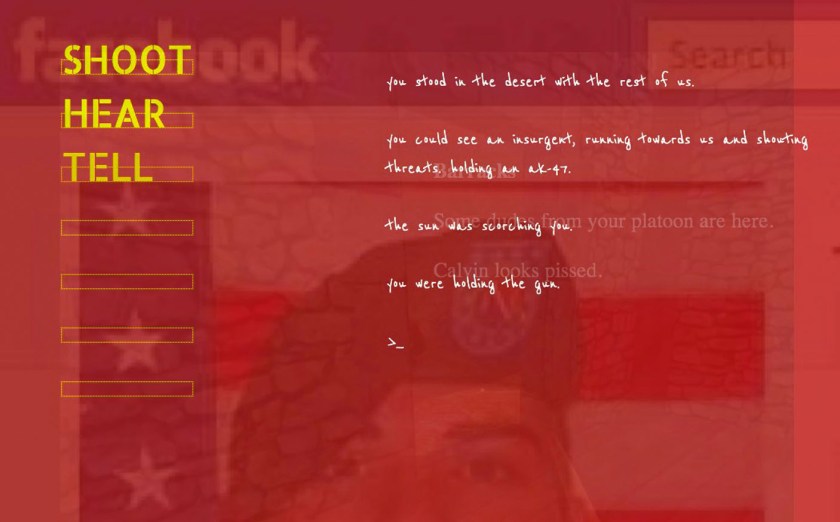
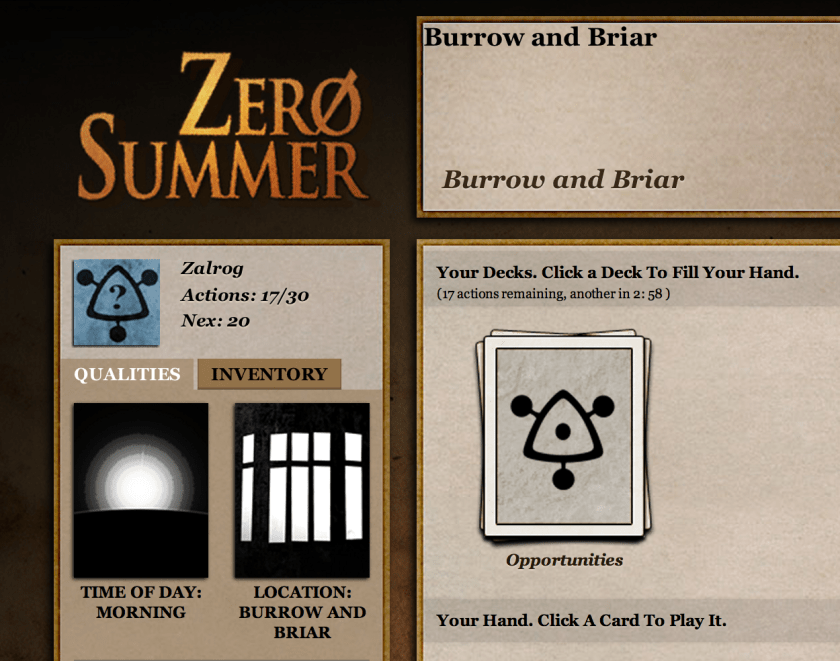




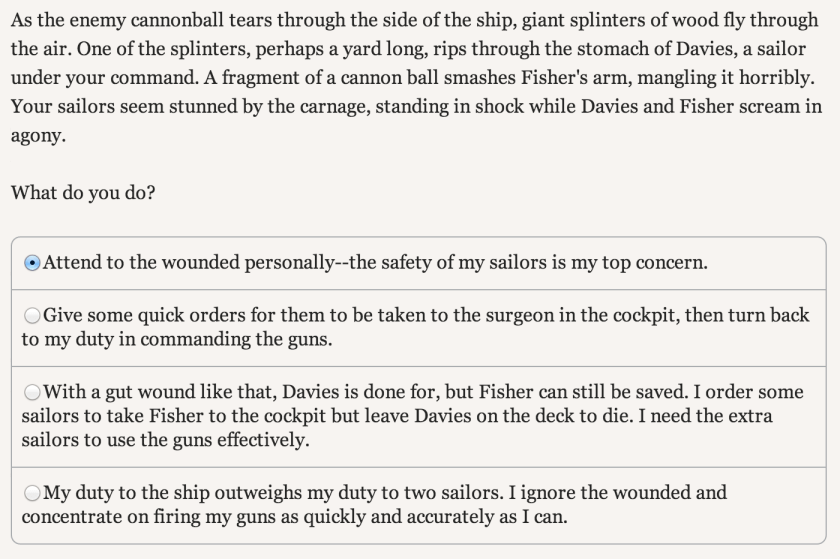




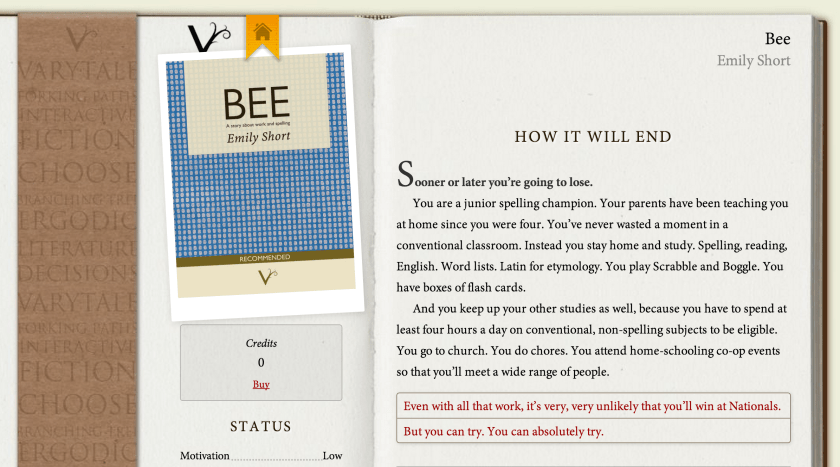
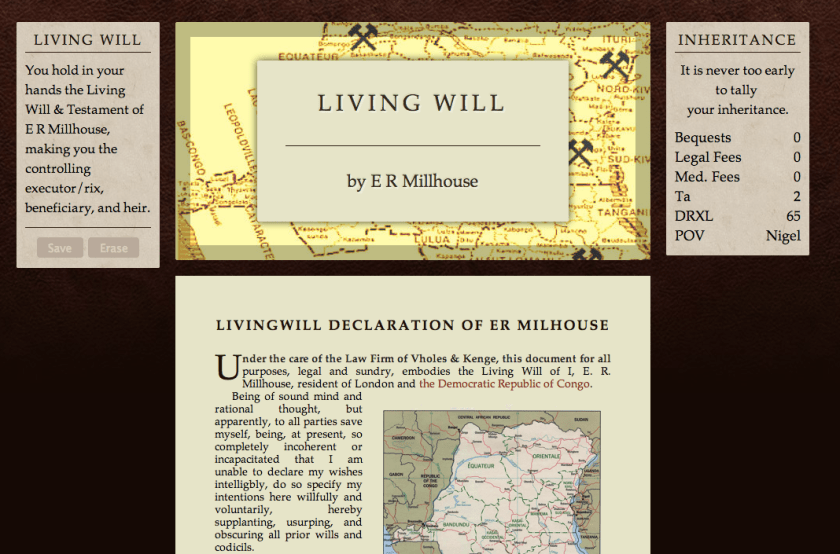
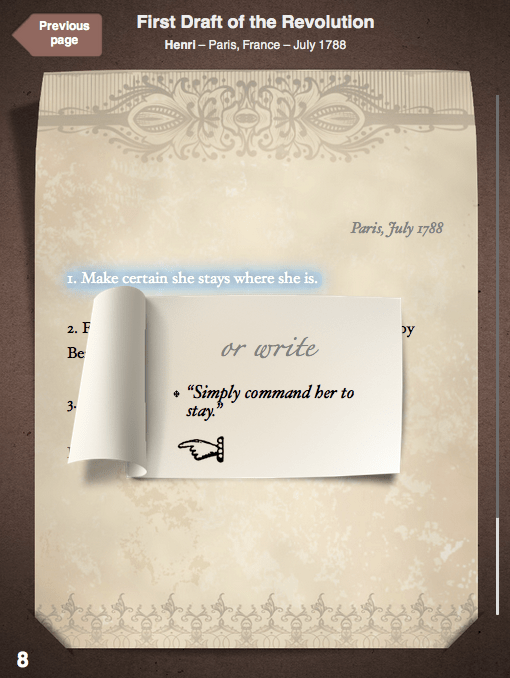




How many times have we heard that the movie is not as good as the book? There is a reason for this common reaction. The human mind is capable of astounding leaps of imagination; all it needs is a springboard, which good, well written text provides better than any other medium.
Yeeeeah, but then I also think movie novelizations are often not as good as the movie, either. Sometimes it’s just that things don’t translate well, or are translated unsympathetically or for the wrong reason.
I’m not trying to start a My Medium Is Better Than Your Medium thing here, just to defend text a bit and encourage people who want to work in it.
You’re right about all this. But I think another important thing about text is: Text is cheap. A few times recently I’ve read that an important limiting factor in AAA games is that making art assets is so damned expensive that the designers need to make sure that you see every single thing they make. (One of those was in Amanda Lange’s post about the latest Final Fantasy, in which she mentions that they couldn’t remake Final Fantasy VII today because the content would be too expensive. Another is in Aaron Reed’s post on Kentucky Route Zero, which is going to get linked in another comment because I only think I get one link per post.)
This means text can be more expansive. You can hide things and let people discover them later, or miss them even. And if we can come up with a way of using dynamically generated text like My Secret Hideout, we might be able to come up with something that has incredible replay value. Not that this is the be-all and end-all, but it tantalizes me… and coming up with convincing dynamic text may seem quixotic, but if one-thousandth of the collective effort was put into text that has been put into the graphics tools people use, it could produce something amazing.
Here’s Aaron on Kentucky Route Zero:
“The more interesting choices in KRZ, however, come from the freeform nature of Act One’s structure, and, especially, the brave design decision to make so much of its content optional. Though you could play straight through the main plot in maybe twenty minutes, the world is stuffed full of rewards for players who linger, who explore…. It struck me that this makes a sharp contrast with narrative design driven by the high cost of content creation. If everything you can interact with is ultimately part of the mandatory puzzle structure, too precious an investment to risk the player ignoring, you’re effectively forced to experience all the content whether you want to or not, like a DM who insists on marching you through every encounter he’s rolled up (or, perhaps more generously, like a traditional book or film). Here, without puzzles to solve and with a generous interpretation of what’s required to advance, what you discover about the world is driven by your own curiosity: there’s no test at the end, just a lot to think about while you wait for the next installment.”
And this is about handcrafted text, not the nuttier thing I was just ranting about.
(I haven’t played this myself — I’m probably going to get it this summer.)
Oh, I agree. We do things in Versu with text that would be very expensive in another medium — dialogue dynamically stitched together from many varied elements; filters changing the presentation of text output; implied changes to the dialogue acting that comes from just gluing in a different adverb, rather than by doing different animation lipsyncing and a whole other take from a voiceover artist.
But I wanted to go beyond that point because it implies a second-best quality to textness, as though everyone would always be using graphics and VO all the time if we only could.
But I think another important thing about text is: Text is cheap. A few times recently I’ve read that an important limiting factor in AAA games…
This depends. Bad text is cheap. Good text is expensive – not just for the time and skill that needs to be dedicated to it, but also in terms of giving some degree of design control to writers (since there’s only so much a writer can do while confined to a box that somebody else has built).
If good writing was cheap, it’d be universal. I don’t think that so many mainstream games feature crappy text because major developers have a perverse antipathy to quality writing: I think it’s because they have some idea of what the costs of quality writing might be, and often judge those costs to be too high.
Well, those are considerations if you weren’t planning to give design control to writers in the first place — if your game is mostly a non-text game. If your game is a text game to begin with, then having the text written well still sounds a lot cheaper than high polygon count art assets from what I’ve read.
I would also say that “AAA games have bad writing because the designers do all the designing first and then bring in the writers to create text within the various straitjackets they’ve set up” is another way of saying “AAA designers don’t care about having good text in their games.” What you’ve described doesn’t sound like a situation where good text would be expensive, it sounds like a situation where good text would require an entirely different approach that might not be more expensive. And I wasn’t actually talking about the quality of writing in AAA games, anyway.
(Also, the argument doesn’t apply to voice acted text.)
“Bad text is cheap. Good text is expensive.”
Couldn’t agree more. Thanks for saying it. :)
I will say, though, that good text is probably less expensive than good graphics — time-wise, money-wise. I think where that equation gets funky is when you start talking about really brilliant writing (instead of good, workmanlike, effective) — because the price tag for brilliant writing can be limitless given that it’s very much a seller’s market.
I agree. On the subject of brilliant writing, I’d guess there’s no price at which you can guarantee it, but nor is there a price at which you can guarantee brilliant anything else. And when text games were the top of the line they got Robert Pinsky to write one — I don’t know if there’s ever been a game designed by a comparably prominent artist….
I’m kind of staggered that text would need such a defence, to the point where you’d have to *rant* about how it can be good (!?!?)
“It’s a very powerful medium for communicating nuance, viewpoint, interiority, motivation, the experience of the outsider. It’s an artistic medium with its own beauties. And because language is all around us, embodying cultural norms and politics, word-mechanics can address big issues.”
I’d say it’s *the* most powerful medium for all of the above, and needing to tell people how it has “its own beauties” kind of baffles me. I’m simply saying it’s hard to imagine in what state of affairs and in front of what crowd is that sort of rant necessary. (I’m certain it was, not implying that you just went off on a crazy tangent up there :))
By the way, something that really warmed my heart yesterday – I read an interview with Colin McComb, the lead designer of Torment: Tides of Numenera, and Pat Rothfuss, whom they managed to snatch for the project as well. Both of them said how they’d like to see CRPGs return to the evocative and narrative power of text as opposed to flashy visuals and expensive voice-acting.
In that case, you’d be surprised how often I’ve heard or seen in comment threads some version of “that’s not a game, it’s all text” or “why are you covering these text things? where are the real games?” or “I don’t play things without graphics” or “if I wanted to read, I’d read a book” or “really?? it’s not the 80s any more!”. Or, from colleagues: “now you’re not just doing this as a hobby, you can use graphics!” or “come on, isn’t your ideal game kind of like the holodeck?”
People like what they like, obviously, and someone who doesn’t want a text game is unlikely to start wanting one because I ranted about it. But I wanted to put out the counter opinion in part for authors who would like to write a text game but feel undervalued.
Was the opposite sort of argument so prevailing at Indie Soapbox and at GDC in general? I mean, haven’t attitudes changed a little bit at least? I mean, I hope you weren’t alone in giving text its due out there.
Very interesting post. As a writer, I of course believe in the merit of words, and would like to throw in my 2 cents. One thing I would have to say is that currently, text can be much more descriptive than computer generated imagery. I can’t tell you how many times I’m pulled out of the game because some animation went wonky, or I could practically count the pixels in a texture. Even more recent games that are touted for their beautiful graphics have this problem, for example, Crysis 2. I find myself staring at the visuals than paying attention to what the polygons are saying.
I will admit that I haven’t played much IF, but a few that I have played have been so well written that I feel like I was there. In this way, text-based games have an advantage over 3D games. I guess my point is, words are more immersive than visuals. I would hope that even if in the future visuals are easy and cheap to make, people will still write books and use words to express themselves.
I was thinking the other day about what a 3D interactive story would look like, and I was imagining how it could basically be the text descriptions of what’s happening, only in 3D. For example, rather than printing out “He smiled warmly,” it would just show a character smiling…warmly. That got me to ask myself, “What’s the point in even having visuals, or a 3D environment for that matter, if it doesn’t change how the player interacts with the story?” I think that’s the fundamental question any designer should ask themselves before they start working in a 3D or even 2D medium. Are the visuals changing what the user can do? If it isn’t important to be able to move around in all three dimensions, is it necessary to implement a 3D engine when the story is more important? Anyway, that was more like a $1.50, so I’ll stop now.
Emily, thanks for posting this. Personally, I think it did really need to be said. And even for those who didn’t need to hear it — paging through lots of interesting examples of text-based computer art can’t possibly hurt.
“It’s an artistic medium with its own beauties.”
Absolutely correct. But text games long ago lost any sort of chance they had, unless some resurgence is around the corner. Games that could tell equally effective stories and engage all the senses more dynamically simply won out. Whether that was for the better or worse is largely irrelevant. But the written word in the form of books has never gone out of style. Text games most certainly did. So I don’t think it’s “just text” that’s the issue. I think it’s largely the mechanics combined with the fact that, by and large, a lot of the text games you find do not have the qualities of those you mentioned in your examples.
“Sometimes in the game industry you encounter people who don’t respect text, or don’t respect the craft of writing,…”
I’ve worked in the game industry for going on twenty years now and I can tell you that most people I work with do respect the craft of writing. What they tend not to “respect” is the idea of text being the sole medium of a gaming experience when more senses can be engaged. The general feeling is that the majority of the market has “voted” on that and made its decision and that, in fact, is largely true. Games like Star Wars: The Old Republic and Guild Wars 2 — in the category of MMOs which don’t traditionally put much emphasis on story — had developers very clearly concerned with the craft of writing. The same applies to Bioshock: Infinite and Dishonored. Many would argue the same for the Assassin’s Creed series. The uproar of fans over the writing of the Mass Effect 3 ending — whether justified or not — showed more passion and interest than anything text games have generated, even in their heyday. The point being that “respecting text” and respecting the craft of writing can be two very different things.
Usually the “respecting text” part comes by integrating that text within and as part of a more dynamic experience of sight and sound. Witness, for example, Guild Wars 2 and how that compares to Guild Wars 1. The former has cutscenes with voice acting. The latter had just text displayed for quests and no voice acting. Many people still respond well to the Guild Wars 1 approach — with text — than to Guild Wars 2. In the latest iterations of The Old Republic, beyond theorycrafting concerns, the most bug reports were for the written codex entries.
So people do value text. People do value the craft of writing. That applies to both developers of games and players of them. What history seems to show us is that, in the case of games, people prefer text as part of a wider context of elements presented to their senses.
“But text games long ago lost any sort of chance they had, unless some resurgence is around the corner.”
Given that the internet seems to be crawling with “twinesters”, and companies centered around text-based CYOA-style games (e.g., Choice of Games) seem to be on the up-and-up, then yeah, I’d say there’s a resurgence going on right now.
“So I don’t think it’s ‘just text’ that’s the issue. I think it’s largely the mechanics combined with the fact that, by and large, a lot of the text games you find do not have the qualities of those you mentioned in your examples.”
Not gonna to argue mechanics with you (there’s been enough discussion about the parser ’round these parts) but I’d say there have been more and better text games with those qualities than “regular” games. I’m not sure why you keep saying that you respect text when the rest of your comment makes it clear that you don’t, not really.
Thing is, the issue isn’t with people preferring “more of the senses”, I think. It’s with the marketplace. All of your examples are AAA games. They’re slightly going out of style, though, aren’t they? Tomb Raider and the latest Halo (I think) raked in the cash and still were considered flops. I think Brian Fargo commented on that. The big ones are straining.
Also, all of these games are kind of action games with some additional story-flavor (usually very mediocre in that department), aren’t they? Text isn’t really suited for that sort of thing, but I’d say that the “dynamic” gaming experience isn’t really that predominant a requirement in the case of, say, mobile devices (mostly ’cause people that use them aren’t hardcore buttonmashers and grinders) and that’s a big market. There are more social mechanisms at play there and it’s something that easy (co-)authoring and sharing of strong story-content really caters to. And for that you simply can’t beat text. Yeah, throw in some cool static art, maybe ambient music, but text would still be the main thing and I’d say it should.